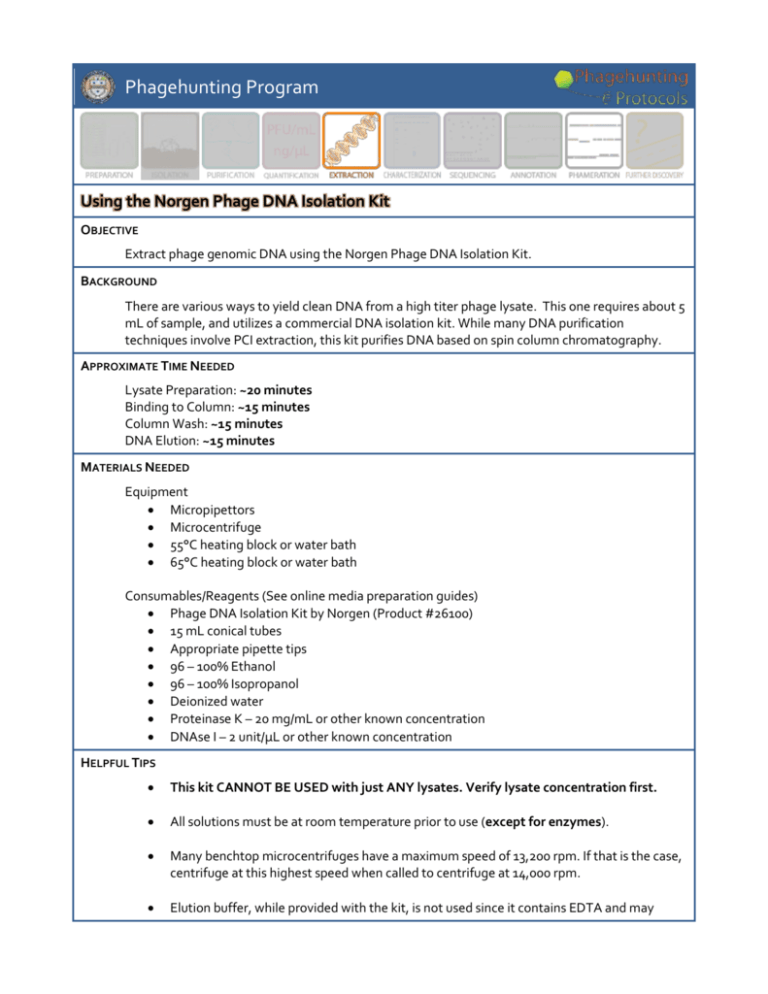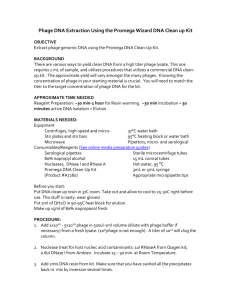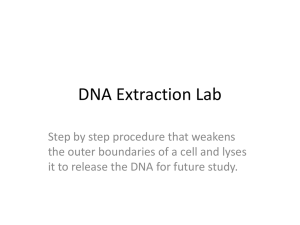Using the Norgen Phage DNA Isolation Kit
advertisement

Phagehunting Program Using the Norgen Phage DNA Isolation Kit OBJECTIVE Extract phage genomic DNA using the Norgen Phage DNA Isolation Kit. BACKGROUND There are various ways to yield clean DNA from a high titer phage lysate. This one requires about 5 mL of sample, and utilizes a commercial DNA isolation kit. While many DNA purification techniques involve PCI extraction, this kit purifies DNA based on spin column chromatography. APPROXIMATE TIME NEEDED Lysate Preparation: ~20 minutes Binding to Column: ~15 minutes Column Wash: ~15 minutes DNA Elution: ~15 minutes MATERIALS NEEDED Equipment Micropipettors Microcentrifuge 55°C heating block or water bath 65°C heating block or water bath Consumables/Reagents (See online media preparation guides) Phage DNA Isolation Kit by Norgen (Product #26100) 15 mL conical tubes Appropriate pipette tips 96 – 100% Ethanol 96 – 100% Isopropanol Deionized water Proteinase K – 20 mg/mL or other known concentration DNAse I – 2 unit/μL or other known concentration HELPFUL TIPS This kit CANNOT BE USED with just ANY lysates. Verify lysate concentration first. All solutions must be at room temperature prior to use (except for enzymes). Many benchtop microcentrifuges have a maximum speed of 13,200 rpm. If that is the case, centrifuge at this highest speed when called to centrifuge at 14,000 rpm. Elution buffer, while provided with the kit, is not used since it contains EDTA and may interfere with certain sequencing reactions of the Ion Torrent. PROCEDURES Verifying Lysate Concentration 1. This kit will not work for just any lysate: if the concentration of the lysate is too high, the binding membrane of the column may rupture, and if the concentration of the lysate is too low, the kit will yield an inadequate amount of DNA. Therefore, it is very important to verify the concentration of the lysate before proceeding. 2. Measure the concentration of DNA in the lysate using the NanoDrop. Be sure to use the directed amount outlined in the protocol (See TOOLBOX: Measuring DNA Concentration), using phage buffer as the blank. 3. The concentration of the DNA should be between 100 – 200 ng/μL. a. If the DNA concentration is too high, dilute only 2 mL of the lysate using phage buffer (w/ CaCl2). Keep in mind that if the concentration determined from the NanoDrop is 2000 ng/μL, a 10-fold dilution—the addition of 18 mL of phage buffer—is required. b. If the DNA concentration is too low, the sample must either be amplified, or undergo an alternative procedure for DNA isolation/extraction. Do not proceed with this kit. Lysate Preparation 4. Transfer 4 mL of phage lysate into four separate 15 mL conical tubes (1 mL in each). a. This serves several purposes: to increase the overall DNA yield by doing two sets of isolations, to balance the centrifuge later in the process, and to generate a back-up in case one of the sets do not work. b. DO NOT use a microcentrifuge tube, since it would not fit in most heat blocks, and the typical 1.5 to 1.7 mL microcentrifuge will not be able to handle the volume of reagents to be added. 5. Add 20 units (10 μL for 2,000 units/mL stock solution) of RNase-free DNAse I to each tube, and incubate at room temperature for 15 minutes. This step is performed to remove host genomic DNA contamination. 6. Add 500 μL of Lysis Solution from the kit to each tube. Vortex vigorously for 10 seconds. 7. Add 4 μL of proteinase K (20 mg/mL) to each tube and incubate at 55 °C for 15 minutes. 8. Incubate at 65°C for an additional 15 minutes. Mix the lysate 2 – 3 times during the incubation by inverting the tube. 9. Add 600 μL of isopropanol to each tube. Vortex to mix. 10. Add 500 μL of Binding Solution from the kit to each tube. Vortex to mix. A white precipitate may form (probably protein). If the amount is large the column may be clogged in future steps. In that case, spin down the lysate before binding at 14,000 rpm for 10 minutes, and use the clear supernatant for binding. Binding to Column 11. Assemble four sets of column with collection tubes from the kit. The following instructions are for individual sets; perform four sets with the identical instructions. 12. Apply up to 650 μL of the mixture with isopropanol onto the column and centrifuge for 1 minute at 14,000 rpm. Discard the flowthrough and reassemble the spin column with the collection tube. Make sure the step of the column’s funnel does not touch any liquid. 13. Repeat #12 until the entire mixture has passed through the column. Column Wash 14. Apply 400 μL of Wash Solution from the kit to the column and centrifuge for 1 minute. Ensure the entire solution has passed through into the collection by inspecting the column. If the entire wash volume has not passed, spin for an additional minute. 15. Discard the flowthrough and reassemble the spin column with its collection tube. 16. Repeat #14 and #15 two times (a total of 3) to wash the column. 17. Discard the flowthrough and reassemble the spin column with its collection tube. 18. Spin the column for 2 minutes to thoroughly dry the resin. Discard the collection tube. DNA Elution 19. Place the column into a fresh 1.7 mL elution tube from the kit. 20. Let sit for 1 – 2 minutes. 21. Add 50 μL of sterile water to the column. Be careful not to touch the membrane with the pipet tip, but ensure that the water fully covers the surface of the membrane. 22. Centrifuge for 2 minutes at 2,000 rpm. 23. Centrifuge for 1 minute at 14,000 rpm. If the entire column has not been eluted, spin the column at 14,000 rpm for an additional minute. 24. The purified DNA sample may be stored at 4°C temporarily, or at –20°C for a few days. It is recommended that samples be placed at –70°C for long-term storage. 25. Combine the four tubes to generate a 200-μL DNA sample. 26. Measure the concentration of DNA on the NanoDrop. (See TOOLBOX: Measuring DNA Concentration).








